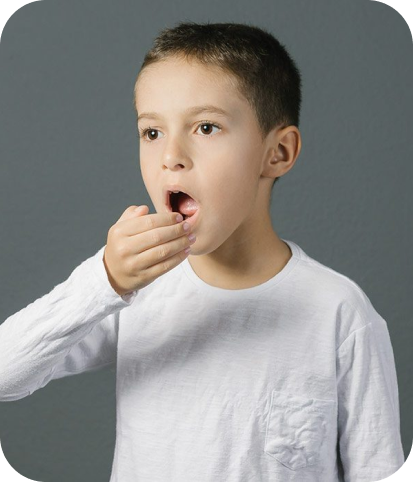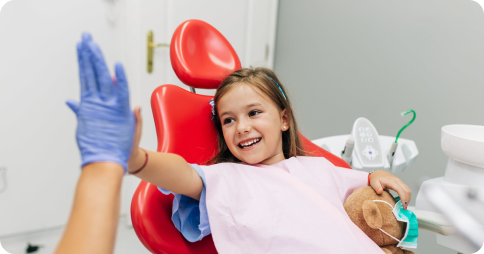Bad Breath (Halitosis)
Halitosis, the medical term for bad breath, can occur in children as well as in adults. Baby bad breath often has a medical or dental cause, while toddler bad breath may be the result of eating too many sweets or not brushing properly. The dentists at Tiny Smiles Pediatric Dentistry — in Woodbridge, New Jersey, on the Lower East Side of Manhattan or in Harlem — determine the cause of bad breath in children, even if it’s bad breath from throat mucus. Call this kid-friendly dental practice today to get answers and treatment for bad breath in kids.

What Is Halitosis?
Halitosis is an oral health condition characterized by bad breath. The causes of halitosis are both external or internal. External causes refer to what you consume, while internal factors refer to what happens in your body.
While halitosis can be a social misstep for adults, the condition also affects children. Bad breath in kids may develop after a meal or after a night’s sleep. If the unpleasant smell doesn’t go away, your child requires a professional check-up by a board-certified pediatric dentist.
Persistent child or baby bad breath may indicate a serious underlying oral health condition. The pediatric dentists at Tiny Smiles Pediatric Dentistry — in Manhattan in Harlem, on the Lower East Side or in Woodbridge, New Jersey — addresses halitosis, as well as a wide range of other dental issues, in your child.

The board certified team of dentists at Tiny Smiles Pediatric Dentistry relies on advanced dentistry equipment and techniques for diagnosis and treatments. These top dentists for kids offer preventative, restorative, aesthetic and orthodontic treatments, as well as special needs dentistry and emergency and urgent care.
Poor oral hygiene. Not brushing and flossing leads to the development of plaque. When food particles stick on the surface of teeth over a long time, bacteria in the mouth thrive and release smelly sulfur compounds.
Stinky foods. Some foods — such as garlic, onions, red meat, fish, cheese and strong spices —release a pungent smell after digestion. Since digestion starts in the mouth, the sulfur compounds released may remain there, leading to bad breath in your child.
Diseases or infections. Halitosis may be a symptom of an infection or disease. It’s possible to suffer bad breath from throat mucus, sinus infections, tooth decay, gum disease, kidney problems, gingivitis, diabetes or oral cancer. If your child practices good oral hygiene, your dentist conducts further tests to identify the cause of the bad breath.
Gastroesophageal reflux disease (GERD). GERD in infants leads to regurgitation, which may lead to toddler bad breath, especially after bedtime. GERD and regurgitation are common in infants, particularly those under the age of 1 year.
Large or swollen tonsils. Deep pits in enlarged tonsils trap food particles, tonsil stones and bacteria. Decomposition in those tonsil pits may release a pungent smell.
Tongue coating. A tongue coated in bacteria, decomposing skin cells and other smelly organic material often leads to bad breath in children. Such material inhabits the back third of a child’s tongue. A whitish appearance on the tongue is an indicator of a coated tongue.
A loose tooth, filling or crown. Food particles trapped under a loose tooth or restoration may rot, causing bad breath. The bacteria feeding on the food particles release pungent sulfur gases.
Foreign objects in the nasal cavity. Stuck objects in the nasal cavity may lead to nasal infections that cause a nasty smell when your child breathes through the mouth.
Xerostomia or dry mouth. Saliva promotes good oral health. Saliva washes away food particles and breaks down acids in the mouth. One common cause of halitosis in children is a dry mouth, especially in the morning. Certain medications and habits, such as finger-sucking and using pacifiers, can decrease the saliva levels in the mouth.

Bad breath in children is a serious condition because of the effect it has on your child’s self-esteem. If other kids comment on the halitosis, your child may lose the confidence to socialize. Bad breath in kids cou-ld also point to underlying medical issues. Contact the friendly pediatric dentists at Tiny Smiles Pediatric Dentistry in one of their three loc-ations to protect your family’s oral health.
How Is Bad Breath in Children Treated?
A pediatric dentist develops an individual treatment plan after exa-mining your child for halitosis causes. After determining the cause of baby bad breath, toddler bad breath or bad breath in older child-ren, your kids’ dentist offers treatment options that may include:
Your NJ dentist may recommend professional teeth cleaning to remove the plaque on your child’s teeth. This procedure may also include a fluoride varnish treatment, applying dental sealants or addressing failing restorations.
If your pediatric dentist identifies poor oral health issues as the cause of bad breath in your child, the dentist talks to your child about good oral hygiene and offers you advice to prevent this and other oral health issues in the future.
After assessing the cause of halitosis in your child, the dentist may recommend a change in diet to avoid foods that may emit sulfur compounds during digestion. Hydration is another recommended dietary change. A more limited consumption of sugary food and drinks prevents decay and other dental issues that lead to toddler bad breath.
To prevent oral issues that may lead to bad breath, dentists recommend regular exams for babies and toddlers. They may need a check-up as often as every six months.
Your child may need treatment for an underlying medical problem, such as diabetes, GERD, sinus infections, tonsillitis, gingivitis, thrush, liver or kidney issues or oral infections.

